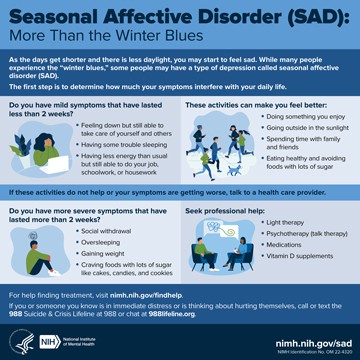By the GWAAR Legal Services Team (for reprint)
As the winter chill settles in and daylight hours diminish, December takes on special significance as Seasonal Affective Disorder (SAD) Awareness Month. SAD is a form of depression that typically occurs during the fall and winter months when sunlight exposure is reduced. This disorder affects a considerable number of people, impacting their mental well-being and daily lives.
SAD is more than just the winter blues; it is a clinically recognized mood disorder. According to the American Psychiatric Association, about 5% of the U.S. population experiences SAD, while an additional 10-20% may experience a milder form of seasonal mood changes. SAD tends to affect more women than men, although researchers are not sure why, and it is also more common among persons living in the northern U.S. states. These statistics and trends highlight the significant impact this disorder has on individuals’ lives, especially during the holiday season.
Although the exact cause of Seasonal Affective Disorder is unknown, it does appear to be linked to a biochemical imbalance in the brain caused by shorter daylight hours and less sunlight in winter, according to the American Psychiatric Association. Decreased levels of sunlight can disrupt both the levels of melatonin (a hormone that regulates our sleep-wake cycle) and serotonin (a chemical that regulates mood) in the body.
SAD shares common symptoms with major depressive disorder, but it is specifically linked to changes in the seasons. It tends to begin in late fall and end in the spring. Key symptoms include:
- Persistent Low Mood: Individuals may experience feelings of sadness, hopelessness, and a general lack of interest in activities they once enjoyed.
- Low Energy Levels: Fatigue and a noticeable drop in energy levels are common, making daily tasks seem more challenging.
- Sleep Disturbances: Changes in sleep patterns, such as oversleeping or difficulty falling asleep, are characteristic of SAD.
- Appetite Changes: People with SAD may experience changes in appetite, often leading to weight gain or loss.
- Difficulty Concentrating: Concentration and focus may become more challenging, affecting work or academic performance.
By recognizing the symptoms of SAD and implementing coping strategies, individuals can take proactive steps to manage the condition and improve their mental well-being. While SAD can be challenging, there are various strategies individuals can adopt to manage symptoms and improve their overall well-being, including:
- Light Therapy: Light therapy, or phototherapy, involves exposure to a bright light that mimics natural sunlight. This has proven to be an effective treatment for SAD by regulating circadian rhythms and improving mood.
- Regular Exercise: Physical activity is a natural mood booster. Incorporating regular exercise into one’s daily routine can help alleviate symptoms of depression and anxiety associated with SAD.
- Nutritious Diet: A balanced diet rich in fruits, vegetables, and whole grains can positively impact mood and energy levels. Omega-3 fatty acids found in fish may also have antidepressant effects.
- Mindfulness and Meditation: Practices such as mindfulness, meditation, and deep-breathing exercises can help manage stress and improve mental clarity.
- Seeking Professional Help: If symptoms persist or worsen, it is important to consult a mental health professional. Therapy, medication, or a combination of both may be recommended based on the severity of symptoms.
So, as we embrace the festive season, let us also foster awareness and support for those grappling with the challenges of Seasonal Affective Disorder.


